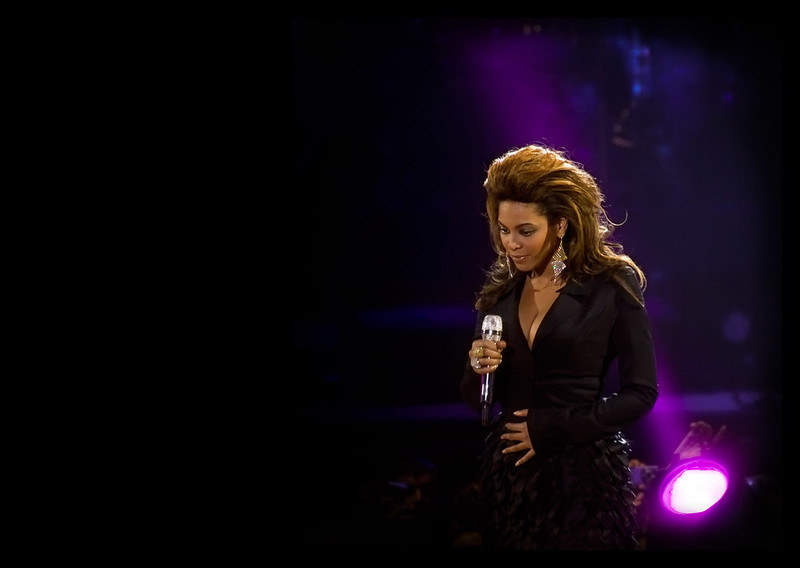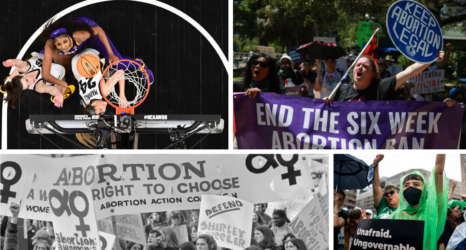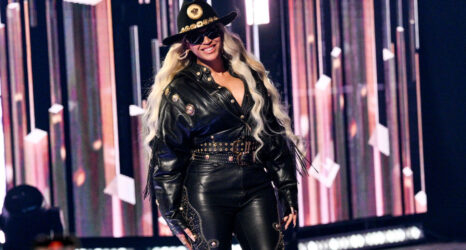
As many of you may know by now, neither the “Feeling Myself” music video nor the unapologetic celebration of voluptuousity that was the “Anaconda” music video were nominated for best video of the year at the MTV Video Music Awards. Nicki Minaj took to Twitter after the snub, calling out the music industry for routinely ignoring the contributions of Black women to pop culture.
Much of the ensuing media attention has focused on “Anaconda” and its in-your-face bootyliciousness, but there’s also plenty to be said about the cultural significance of the “Feeling Myself” music video. The song itself has already become an anthem of self-love, and the video takes that message even further through its depiction of the friendship of Minaj and Beyoncé.
The much-anticipated video for Minaj’s “Feeling Myself,” the swaggering, take-no-prisoners bravado of a victory track from The Pinkprint, was supposed to be a Tidal exclusive, but that didn’t stop fans from uploading it to social media and video-sharing platforms. (You can watch the video below, but for a high-quality version, you need to be Tidal subscriber.)
Minaj and her guest vocalist, Beyoncé, exude the confidence of women who know they own the world. As Beyoncé boasts in the first bridge, “I stopped the world/Male or female, it make no difference/I stop the world,” the combined powers of the two performers extend beyond the curve-hugging, Tumblr-chic outfits and shameless exhibition of the pleasures of self-love. The video, with its close-cut scenes of wolfing down hamburgers, twerking and primping by the (kiddie) pool, is meant to feel personal, as though the camera is only capturing unfiltered moments.
Although it may dip into the realm of Cool Girl elitism, the pairing of Minaj and Beyoncé invokes female autonomy and inherent authority without the pressure or consideration of the male gaze. Although the video literally begins with a faceless cameraman addressing both women (and by obvious implication, their beauty), the crux of the video doesn’t rely on performing for the sake of attracting gawkers. Men are an afterthought, akin to a flashy accessory. Minaj raps, “National anthem hats off, then I curve that n*gga like a bad toss,” affirming the idea that her self-worth does not revolve around the approval of men. A rowdy, slinkier descendant of Janet Jackson’s “Control” and glued together by the self-assurance sprouted in Minaj’s mixtapes, the song’s repeated hook makes it clear that both Minaj and Beyoncé’s self-importance isn’t anchored to the praises of men.
In one shot, Beyoncé and Minaj share the familiar camaraderie of two innocent school girls, dropping their video personas. Minaj is eating a piece of candy and Beyoncé asks, “Is that Bubblicious gum?” Minaj says that it’s not – she’s eating a Now & Later. She offers some to Beyoncé, who stares at the candy as though it were a gallon of fresh water sitting unattended in the desert. It’s such a trivial moment, a nonessential piece of footage that most directors would cut. Yet the intentional placement of this shared moment suggests that the two women, commanding and powerful in their respective spheres of the music industry, are friends and at the very least, have mutual respect.
Marni Senofonte, the stylist for the video, told Marie Claire,
It [the shoot] was a total girlfriend vibe…It was really amazing to see two of the biggest female stars in the world acting in that way…Beyoncé is known for being a girl who sings and talks about supporting and it was really a true testament to that…It was like a documentary.
In another GIF-worthy scene, the two feed each other hamburgers in color-coordinated outfits, Minaj sporting a pristine-white fur coat. In another shot, Minaj playfully throws French fries into Beyoncé’s open mouth. A bounce house hovers in the background, the kind typically reserved for children’s birthday parties.
The universal message of “Feeling Myself” is a softer version of Beyoncé’s “Bow Down.” Minaj is in full command of her career, whether that be her financial prowess (“Got a black card that let Saks have it”), or her cultural relevance (“Bitches ain’t got punchlines or flow/I have both and an empire also”). As one of few female MCs, Minaj has been eager, even hungry, to prove her lyrical and creative authenticity. Her public persona has been shaped by the importance of female self-empowerment, of claiming a narrative that has been very much angled as the steadfast survival of a lone wolf. In the opening verse, she spits, “Never left but I’m back at it.” It’s not a threat but a reminder, a reaffirmation of her drive, ambition and relevance. At one point, Beyoncé’s first bridge referencing her record-breaking, self-titled fifth album, is set against the backdrop of a frenzied crowd at this year’s Coachella. There’s a flash of Minaj and Beyoncé backstage at the festival, beaming, laughing, wearing outfits no different than the other festival-goers. Then we’re back to the pair floating around the pool, makeup impeccable.
The women prove their financial and social power in both literal and non-explicit forms of expression, namely the video’s marketing and strategic business ties. Beyoncé and Minaj are both Tidal shareholders, a company that is owned by Beyoncé’s husband, Jay Z. So far Tidal hasn’t made much of a splash, at least not in the positive ways that its CEO, who famously proclaimed, “I’m not a businessman, I’m a business, man,” intended. In a promo video for the service, what was supposed to be a serious proclamation for the forging of a new, untraveled path in the intersection of music and technology, was quickly mocked for its tone-deaf megalomania.
Bloomberg called Tidal “a complete disaster” going on to speculate,
To keep his company from becoming a money pit, Jay Z also needs to line up many more Tidal subscribers. Tidal claims to have 900,000 users, but analysts suspect many have signed up for trials and will cancel when they have to start paying.
What better way to entice people to buy a subscription, wary consumers included, than to suddenly premiere a new video featuring two of the industry’s biggest female superstars turned moguls?
Minaj and Beyoncé have broken out of the box of just pop stars or flash-in-the-pan wonders; they’re masters of their own universe, turning their careers into certified, money-churning brands. Minaj has steadily racked up endorsement deals, ranging from a multi-million deal with Pepsi, a MAC and OPI collaboration, a successful line of fragrances, a clothing line for K-Mart, a memorable stint as guest judge on American Idol, movie roles, a spring/summer fashion campaign for Roberto Cavalli, and most recently, buying a stake in alcohol brand Myx Fusion. Beyoncé has leveraged her established brand into new heights through the strategic usage of social media, dropping lush vacation photos on her Tumblr and posting #OOTD snaps to Instagram to enforce her aspirational lifestyle. Their fame has been crafted by unwavering diligence as much as it has been guided by ambitious defiance. Both women take pride in their social, cultural and financial status, echoed by Minaj’s lines in the song’s third verse: “Stingin with the Queen B and we be whippin’ all that D/Cause we dope girls we flawless, we the poster girls for all this.” Last year, Forbes declared Queen B the highest-paid female musician.
In a piece for The Guardian, Tshepo Mokoena writes,
When Bey and Nicki sing that they’re feeling themselves, they’re reminding the listener of their pop culture relevance and self-confidence. When you sing along, you’re letting the world know that now the song’s message is about you. It’s a glossy, unapologetically self-assured take on the announcement Aretha Franklin and Annie Lennox belted out in 1985: we’re doing it for ourselves now, and the rest of you need to just deal with it.
If Minaj and Beyonce are on the top of the industry mountain, they are not secretly plotting ways to shove the other off the edge and into the oblivion of irrelevance.
One could argue that the video embodies aspects of the “Carefree Black Girl” movement, which started as a Twitter hashtag and quickly caught on as a counter-narrative to the tired stereotypes and bigoted cultural tropes used against Black girls and women. In an article for BuzzFeed, Hannah Giorgis discusses the importance of musicians challenging the expected narrative, mentioning Kelis, Erykah Badu, Trina, and Rihanna as prime examples. These women reject society’s insistence that Black women can only live the tropes of the Jezebel, the Mammy, the Welfare Queen, etc., instead choosing the satisfaction of worry-free self-fulfillment.
As Giorgis rightly points out,
In a world that tells Black women we have no right to authentic joy and no purpose in the music industry beyond an ornamental backdrop for male brilliance and bravado alike, their deft maneuvering is a choreography of resistance.
The song and accompanying video are certainly not about hiding or self-doubt. “Feeling Myself” is a mantra of personal excellence on one’s own terms. In order to achieve such impressive feats, a woman has to learn to love herself in spite of the eyes of a voracious audience.
Photo of Beyonce courtesy of Bigotes de Gato | Fotografía on Flickr, licensed under Creative Commons 2.0





